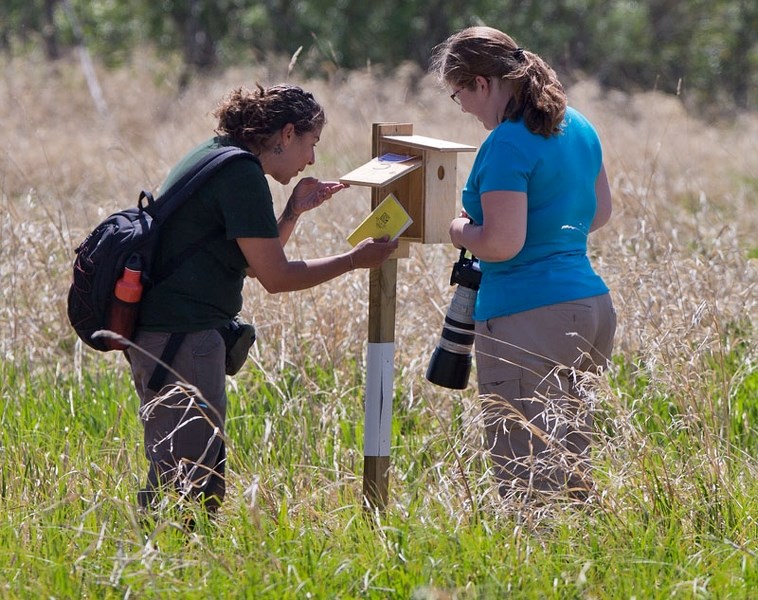There's a tiny new subdivision at Big Lake, and it could help scientists figure out how pollution affects birds.
Big Lake watchers may have noticed a small neighbourhood of birdhouses materialize just south of the Big Lake Environment Support Society platform last month.
Those homes are part of a three-year study on tree swallows by University of Alberta PhD student Natalia Lifshitz that aims to use bird feathers to track the effects of pollution on animal health.
Tree swallows are small, agile, insect-eating birds with white chests and dark-blue heads and wings, says Alan Hingston, a birder with BLESS familiar with Lifshitz's work. While they normally nest in tree hollows, they readily set up shop in nest boxes.
Lifshitz says she chose tree swallows for her study because they were easy to catch (unlike mallards) and have brilliant colours. They're also of interest from a conservation perspective, as they, like all insectivorous birds, are on the decline in North America.
Tree swallows absorb pollutants through the insects they eat, Lifshitz says. Her theory is that these pollutants worsen the birds' health and reproductive success, and that this will be reflected in their plumage: swallows at polluted lakes should have duller colours than those at cleaner ones.
In the first year of her study, Lifshitz set up nest boxes to collect tree swallows at Beaverhill Lake by Tofield and in downtown Edmonton. She wanted another low-pollution site this year, and heard that Big Lake had a lot of swallows.
BLESS had worked with Lifshitz's supervisor, U of A biologist Colleen Cassady St. Clair, in 2012 to test bird-detecting radar at Big Lake, Hingston says. She hooked Lifshitz up with BLESS, who directed her to Hingston, who helped her find an appropriate test site.
Lifshitz says she installed 24 nest boxes at the lake in mid-May. The swallows were checking out the boxes moments after they went in, and about 13 of the boxes are now home to nesting birds.
Lifshitz urged residents to stay away from the boxes as a result.
"The adults get very protective of their chicks," and will dive-bomb and scream at anyone who gets near them.
Feather science
About 13 days after the eggs hatch, Lifshitz and her team will pluck a few back feathers from the adult swallows in each box and study them with a reflective spectrometer to determine their colouration. They'll also analyze the feathers for heavy metals and compare them with ones collected at Beaverhill and in Edmonton.
"These kinds of water management facilities, like wetlands, are used all around the world," Lifshitz says, so it's important for us to understand how they affect birds.
If pollution is affecting the health of these swallows, it could mean that these manufactured wetlands are evolutionary traps, she says – places they've evolved to seek out as good breeding grounds that actually spell their doom.
Lifshitz's research could give researchers a way to spot population declines in birds earlier, Cassady St. Clair says. It could also be applicable to the oilsands, which feature many polluted lakes (tailings ponds) that are host to birds.
Lifshitz says she'll take down the Big Lake nest boxes in July and may bring them back for year three of her study. She also hopes to put tiny cameras in the boxes next year to analyze the bird's feathers without sampling them – a technique that could help researchers study many other species in the wild non-invasively, Cassady St. Clair says.
One of the main suspects for declining swallow populations is pesticide use, Lifshitz says. Residents can help swallows by using less of these chemicals.
If you live by a wetland, you can also put out nest boxes to give these birds a home, Cassady St. Clair adds.
"It's really fun to watch swallows. They're such acrobats and they're really beautiful and they like to perch on top of their boxes."




